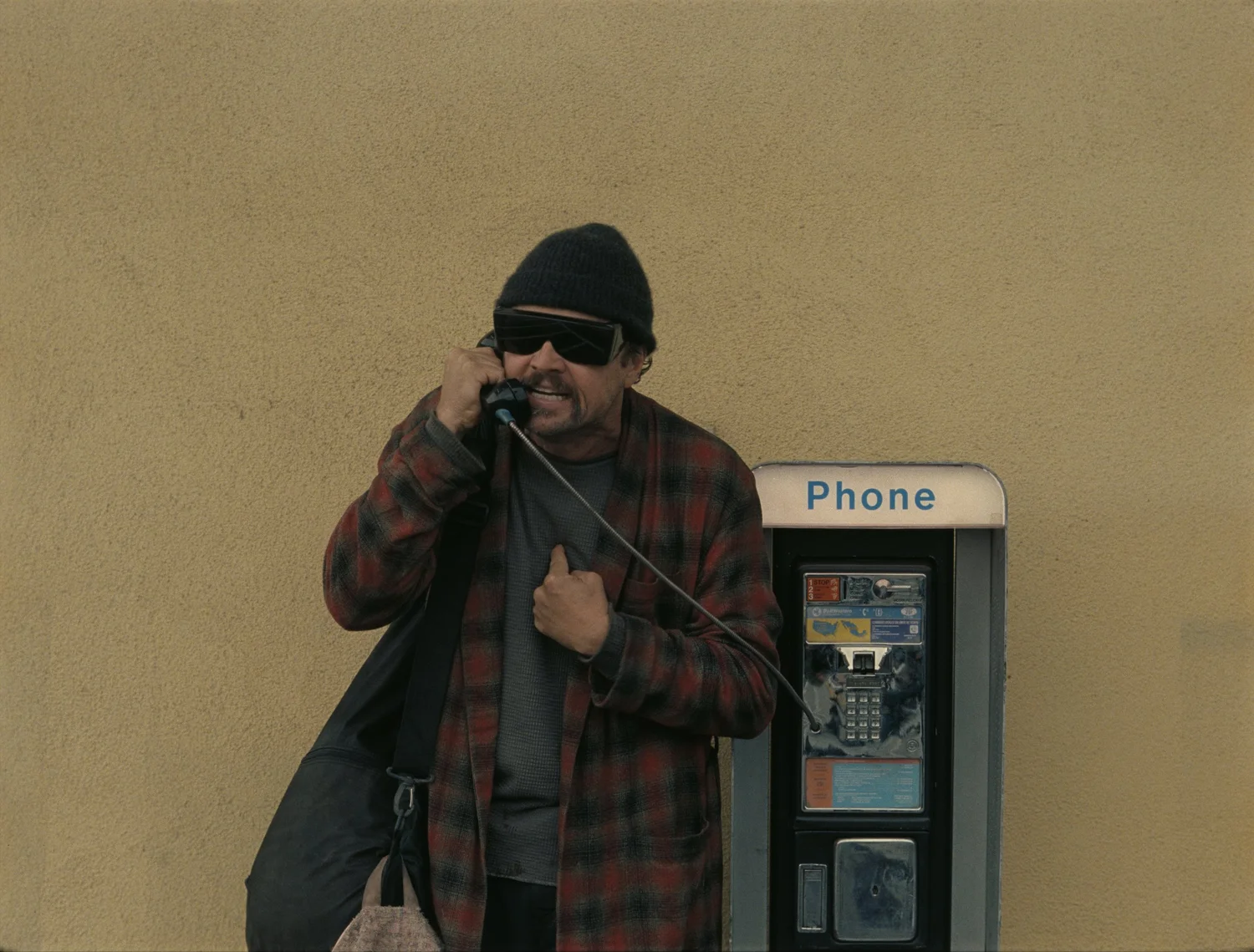Images courtesy of Warner Bros. Pictures
ONE BATTLE AFTER ANOTHER— 5 STARS
Incontrovertibly, the loudest word reverberating out of Paul Thomas Anderson’s imposing crime saga and instant awards season juggernaut, One Battle After Another, is “revolution.” When an ambitious movie, no matter the subgenre, invokes that term as its core for conflict, it sets out to establish a setting and context of corruption while positioning a potentially dramatic and dangerous chessboard of characters prepared to take risks and fight against their marked opposition. Sides are chosen and labeled, and not all the chess pieces or hats are entirely black or white.
LESSON #1: THE INTRIGUE OF REVOLUTION— Make no mistake, when movies present some form of revolution, whether it’s on the scale of Metropolis, V for Vendetta, Fight Club, The Matrix, or RRR, the intrigue intensifies. We want to see who dares to have the cajones to take on the presented evil at hand because—from the comfort of a theater seat or couch cushion, ready to soak in the escapism of cinema—there’s a sense of “better them than us” at that moment. We love underdogs and welcome the chance to lionize a few fictional Robin Hoods and real-life Che Guevaras. We want to see, hear, and, most importantly, learn about their motivations and convictions.
Normally, the entertaining act of witnessing is plenty for a cinephile or paying customer. However, when a movie invokes revolution as its central theme, it also takes on the embedded cause and champions it beyond its running time. If the inspirational draw of watching revolution in action is fulfilled, that ingrained ideal can very well echo and become bigger than the film itself. The movie can become a flag bearer. Now, in that higher, glorified form, the intrigue surges further than ever thought possible. In equally wacky and undaunted ways, that is precisely the power of One Battle After Another.
Academy Award winner Leonardo DiCaprio stars as “Ghetto” Pat Calhoun, a member of the radical group calling themselves the French 75, specializing in explosives and electronics. One Battle After Another opens with Jonny Greenwood’s intense score and Licorice Pizza cinematographer Michael Bauman’s camera strafing through French 75’s coordinated infiltration of the Otay Mesa Detention Center outside of San Diego. The tight faction (including Wood Harris, Alana Haim, Shayna McHayle, and Regina Hall), led by the ravishing and unyielding Perfidia Beverly Hills, played by actress and recording artist Teyana Taylor of Coming 2 America, is there to disrupt operations and liberate the detained illegal immigrants. In doing so, Perfidia crosses paths with Col. Steven J. Lockjaw (two-time Oscar winner Sean Penn, in a dynamite role), the ranking officer on site.
LESSON #2: WHO HAS POWER OVER WHO?— For Perfidia, the French 75’s mission is about taking back power from oppressors, with the slogan of “Declare war. Free Borders. Free Choices.” Even though she has a new baby daughter, Charlene, with Pat, she puts the cause before her family. After the immigration facility takedown, the group orchestrates brazen bombings and robberies of political and financial targets across the American Southwest. Her actions draw the ire and the lusty desires of the corruptible Lockjaw. Looking to correct his embarrassment, the victim becomes the hunter as the Colonel assembles the might of the military for his mission to apprehend or eliminate anyone connected to Perfidia or French 75.
It is a vendetta Lockjaw would carry for 16 years as One Battle After Another leaps the narrative forward after the big inciting incident. Thrust with a go bag, off-the-grid trackers, and an envelope of new identification, Pat and Charlene are forced to go into hiding without Perfidia in the sanctuary city of Baktan Cross outside of El Paso, Texas, with the new identities of Bob and Willa Ferguson. The girl (Chase Infiniti, making her film debut) is now a headstrong high schooler, warned and yet sheltered from the family’s checkered past by Bob, who’s become a paranoid burnout.
Things are fine and dandy until Regina Hall’s Deandra returns unexpectedly to evacuate Willa with the arrival of Lockjaw and his strike force at a school dance. Separated from his daughter and way out of practice in his former spycraft, the high-as-a-kite Bob gets shelter and help from Willa’s karate instructor Sergio St. Carlos (fellow Oscar winner Benicio del Toro). The kindly man moonlights as his own Harriet Tubman to lead a vast Underground Railroad-esque network of illegals hidden behind his business fronts, another thing Lockjaw has no problem snuffing out while chasing his quarry. From there, an accelerated, multifaceted, and madcap on-the-lam pursuit launches forth from One Battle After Another with more twists than a bag of pretzels.
LESSON #3: ATTACKING ANTI-FACISM— Across Lesson #2, the contextual intent and adopted cause of Anderson’s film is identified, and it’s a conservative pearl-clutcher’s nightmare: anti-facism. And, much like the topic of revolution, anti-facist message movies have their own storied Hollywood history to explore as well. Even though Paul Thomas Anderson is loosely adapting Thomas Pynchon’s 35-year-old novel Vineland, the chosen spotlight—in a stroke of serendipitous luck—couldn’t be more fitting to 2025, which will lead many One Battle After Another viewers to project fiction to reality. Even if the mirrored topic can slap the current state of public turmoil across the face, the writer-director still has his slant. True to the unconventional and labyrinthine storyteller he is, Paul Thomas Anderson deftly hides the scope of the fascism and the shocking depth of its influence behind a few alarming and bizarre curtains.
This may all sound grand and important, but remember, this is a Paul Thomas Anderson film—the man behind Boogie Nights, The Master, Inherent Vice, Phantom Thread, and There Will Be Blood—meaning the epic tapestry sewn of this movie’s pillars and principles is decidedly dirty and dingy. One Battle After Another gets its heat through mouthpieces spewing uncouth hot air and exhaled marijuana fumes with personas prone and primed for violent acts and seedy twists of sexualization. Like so many of Anderson’s plots, shit is guaranteed to hit the fan, and anything that could go wrong often does, creating a cavalcade of fuck-ups that veer from nightmarish to cartoonish at the drop of a hat or the pull of a trigger. Look no further than the stoner comedy pitfalls beset upon Leonardo DiCaprio’s protagonist when the screws are tightened, forcing the layabout to become a borderline incompetent man of action, something the Oscar winner is an expert at conveying with frazzle and resolve.
Granted his largest budget of his career and big studio backing from Warner Bros. Pictures, Paul Thomas Anderson is hiding something in his signature swerves. One Battle After Another has a secret weapon, and it’s Chase Infiniti. Having her character emerge as both the pursued target of a buried past and the potential bright hope for a revolution’s future legacy makes Chase a massive source of sympathy and consequence. The best suspense of One Battle After Another channels through her. Playing his age for a change as her scruffy protector, DiCaprio manages to create a surprisingly endearing father-daughter dynamic with Infiniti, which may just melt your heart through all the smoke and sweat. The only thing missing is more Teyana Taylor.
Nevertheless, that sprinkle of uncommon wholesomeness amidst the nefarious affairs and firebranded upheaval loudly consuming One Battle After Another from all directions should not succeed, let alone flourish as brilliantly as it does. On paper and spelled out, Paul Thomas Anderson’s movie—rife with a secret society of white supremacists, spontaneous erections, clandestine dedication to passwords and code talking, peppy soundtrack breaks from multiple eras and genres, chugged Modelos, karate bows, and machine gun-totting nuns—reads like traits and features akin to a “This place has everything…” list from Bill Hader’s old city coorespendent Stefon character on Saturday Night Live’s “Weekend Update.” Instead, you have one of the best filmmakers of his generation using all of his prowess and technical acumen on large-format film to make something utterly absurd into a woolly opus that is wildly compelling and intoxicating to watch from every angle.
LOGO DESIGNED BY MEENTS ILLUSTRATED (#1338)



